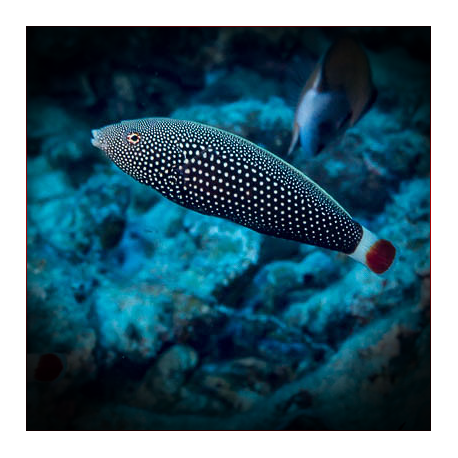More info
Datasheet
| Minimum Tank Size | 500 litres / 132.09 US gallons |
| Maximum Size | 17.0cm / 6.69inches |
| Reef Compatible | Always reef safe |
| Temperament | Docile but might be aggressive towards similar species of same gender |
| Temperature | 22.2°C / 71.96°F - 25.6°C / 78.08°F |
| Specific Gravity | 1.020-1.025 |
| Carbonate Hardness | 8-12 |
| pH | 8.1-8.4 |
General Description
The Red Tail Wrasse, scientifically known as Anampses chrysocephalus, belongs to the Labridae family. These fish are recognized for their striking appearance, with notable variations between juveniles and adults, as well as males and females. They can grow up to 17.0cm and are primarily found in Japan and the Central/West Pacific region.
Aquarium Suitability
The Red Tail Wrasse is considered delicate, requiring experienced aquarists to thrive. It is recommended to keep them in pairs (one male and one female) or with one male and multiple females. These fish are known to jump out of open aquariums and acclimatize best when introduced at a young age.
Demands, Care, and Hardiness
This species demands extra care and attention due to their delicate nature. They are very sensitive during transportation and acclimatization into aquariums and should be handled with caution. The Red Tail Wrasse is docile but can exhibit aggression toward similar species of the same gender. They are shy and tend to bury themselves in sand when threatened or resting.
Reef Suitability
Red Tail Wrasses are known to be reef-safe, making them ideal additions to reef aquariums. They are excellent for controlling unwanted invertebrates commonly found in reef environments, such as flatworms and pyramide snails.
Aquarium Setup
To ensure the well-being of the Red Tail Wrasse, it is essential to provide a tank with a minimum capacity of 500 liters. The aquarium should have a deep sandy substrate of at least 5 cm to allow the fish to burrow when feeling vulnerable or in need of rest. They are best suited to tanks with peaceful species or in a small group with one male to reduce stress.
Behaviour
These Wrasses are typically peaceful towards other tank mates and thrive in small groups. When feeling threatened or insecure, they exhibit a burying behavior in the sand. They can be shy initially and may take time to acclimate to new surroundings until they feel comfortable to explore and feed more boldly.
Feeding and Diet
The Red Tail Wrasse requires frequent feeding, especially when newly introduced to an aquarium. Their diet should include live food, small crustaceans like krill and mysis, and zooplankton such as cyclops and pods. Once acclimatized, they can feed less frequently if natural food sources are available in the tank.
Dimorphism and Captive Reproduction
These Wrasses can change gender from female to male, where a female transitions to take on the male role. This species comes in multiple color variations, which can pose challenges in identification. Successful captive reproduction is more likely when live food is provided to help them adapt to tank conditions.
Habitat and Distribution
Red Tail Wrasses are native to Japan and the Central/West Pacific region. They inhabit diverse marine environments and are commonly found in reef aquariums due to their reef-safe nature and utility in controlling invertebrate populations.

